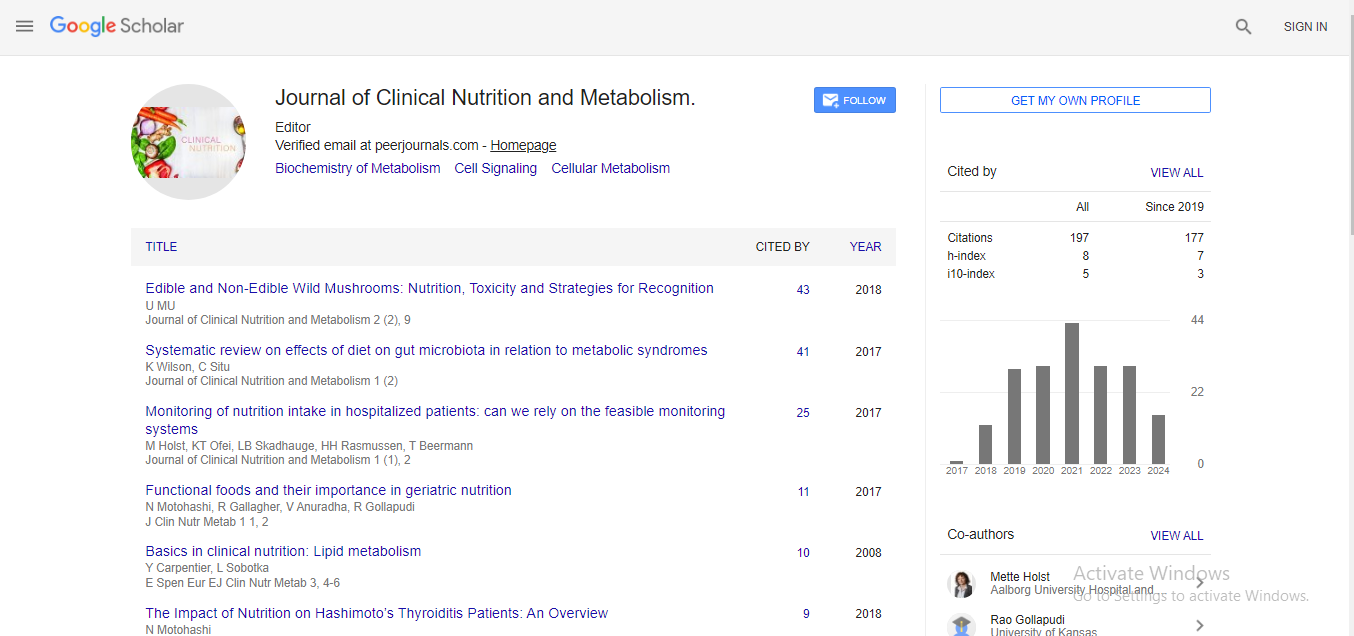Opinion Article, J Clin Nutr Metab Vol: 8 Issue: 1
Metabolic Shifts in Postprandial Glucose Regulation: Insights from Novel Nutritional Interventions
James Smith*
1Department of Clinical Nutrition, Harvard T.H. Chan School of Public Health, Boston, MA, USA
*Corresponding Author: James Smith,
Department of Clinical Nutrition,
Harvard T.H. Chan School of Public Health, Boston, MA, USA
E-mail: Smithjames_5@gmail.com
Received date: 28 May, 2024, Manuscript No. JCNM-24-143623;
Editor assigned date: 30 May, 2024, PreQC No. JCNM-24-143623 (PQ);
Reviewed date: 14 June, 2024, QC No. JCNM-24-143623;
Revised date: 21 June, 2024, Manuscript No. JCNM-24-143623 (R);
Published date: 28 June, 2024, DOI: 10.35841/JCNM.1000147
Citation: Smith J (2024) Metabolic Shifts in Postprandial Glucose Regulation: Insights from Novel Nutritional Interventions. J Clin Nutr Metab 8:2.
Description
Postprandial glucose regulation, the body's management of blood sugar levels after eating, is essential for overall metabolic health. The postprandial period is when blood glucose levels rise following a meal, triggering a series of physiological responses aimed at maintaining glucose homeostasis. However, irregularities in this process can lead to chronic conditions such as type 2 diabetes. Recent advancements in nutritional interventions offer promising insights into how metabolic shifts can be managed more effectively. After consuming a meal, carbohydrates are broken down into glucose, which enters the bloodstream and raises blood sugar levels. In response, the pancreas secretes insulin, a hormone that facilitates glucose uptake by cells, thus lowering blood sugar levels. For individuals with effective postprandial glucose regulation, this system maintains glucose within a healthy range, minimizing spikes and troughs. However, in many cases, this process can be disrupted, leading to prolonged high blood sugar levels. This disruption is often a sign of insulin resistance, a condition where the body’s cells become less responsive to insulin, requiring more of it to manage blood glucose levels. Such metabolic shifts can eventually progress to type 2 diabetes, highlighting the need for effective management strategies.
Recent research into nutritional interventions has shed light on innovative approaches to improving postprandial glucose regulation. These interventions focus on modifying diet composition, meal timing, and specific dietary components to enhance glucose management. Foods with a low glycemic index are digested and absorbed more slowly, leading to gradual increases in blood glucose levels rather than sharp spikes. Incorporating low GI foods such as legumes, whole grains, and certain fruits can help improve postprandial glucose control. Studies have shown that low GI diets can reduce the risk of type 2 diabetes and improve overall glycemic control in individuals with prediabetes.
Dietary fiber, particularly soluble fiber found in foods like oats, beans, and vegetables, can slow the absorption of glucose and improve insulin sensitivity. High-fiber diets have been associated with lower postprandial glucose levels and reduced insulin resistance. This effect is partly due to fiber’s ability to form a gel-like substance in the gut, which slows the rate of glucose absorption. Intermittent fasting involves cycling between periods of eating and fasting. Recent studies have suggested that intermittent fasting can improve insulin sensitivity and reduce postprandial glucose levels. The metabolic shifts induced by fasting periods appear to enhance the body’s ability to manage glucose more effectively when food is reintroduced.
The timing of meals and nutrient consumption can also influence postprandial glucose regulation. Emerging evidence indicates that consuming a larger portion of daily caloric intake earlier in the day may be beneficial. This approach, often referred to as “early timerestricted eating,” aligns meal timing with the body’s circadian rhythms, potentially enhancing glucose metabolism and reducing the risk of insulin resistance. Adjusting macronutrient ratios within meals can affect glucose response. Increasing protein intake, for example, can help reduce postprandial glucose spikes by slowing down the digestion and absorption of carbohydrates. Similarly, incorporating healthy fats into meals can moderate glucose absorption rates and improve glycemic control. Certain foods and supplements have shown promise in improving postprandial glucose regulation. For instance, the consumption of cinnamon, berberine, and alpha-lipoic acid has been linked to enhanced insulin sensitivity and better glucose management. These functional foods and supplements may offer additional tools for managing glucose levels, especially when combined with dietary modifications.
Understanding how these interventions affect postprandial glucose regulation involves exploring their underlying mechanisms. Low GI foods and high-fiber diets primarily work by slowing glucose absorption and improving insulin sensitivity. Intermittent fasting and early time-restricted eating influence metabolic rhythms and may enhance cellular glucose uptake. Adjustments in macronutrient ratios affect the rate of digestion and glucose absorption, while functional foods and supplements may have direct or indirect effects on insulin action and glucose metabolism. Future research should continue to explore the long-term impacts of these nutritional strategies, particularly their effectiveness in diverse populations and their potential for combination with other therapeutic approaches. Additionally, personalized nutrition, considering individual metabolic responses, genetic predispositions, and lifestyle factors, will be important in tailoring interventions for optimal postprandial glucose control.
Novel nutritional interventions offer valuable insights into managing postprandial glucose regulation and improving metabolic health. By adopting low GI diets, high-fiber foods, intermittent fasting, and strategic meal timing, individuals can better manage blood sugar levels and potentially reduce the risk of metabolic disorders. As research continues to evolve, these interventions will become increasingly refined, offering more personalized and effective strategies for maintaining glucose homeostasis and promoting overall health.
 Spanish
Spanish  Chinese
Chinese  Russian
Russian  German
German  French
French  Japanese
Japanese  Portuguese
Portuguese  Hindi
Hindi 